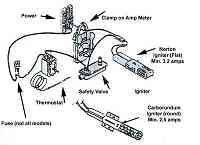There are as many different ways of installing an icemaker water supply line as there are people doing it. Some are good, most are marginal or just plain wrong. Here’s a handy list of reminders on the correct way to install a water supply line from the source to the water inlet valve on the refrigerator:
 You’ll find all kinds of el cheapo plastic tubing kits out there in the hardware sections of Wal-Mart or wherever but 1/4″ copper tubing is the gold standard.
You’ll find all kinds of el cheapo plastic tubing kits out there in the hardware sections of Wal-Mart or wherever but 1/4″ copper tubing is the gold standard.- Connect the water line to a frequently used cold water line so you’re sure to use only fresh water to make your ice cubes.
- If you have a choice between a vertical or a horizontal water line to tie into, always pick the vertical line.
- Use a horizontal line if and only if a vertical line is not accessible.
- On horizontal water lines make your connection on the top or sides of the pipe, never on the bottom. If you install the saddle tee valve on the bottom of the pipe, you’re pretty much guaranteeing a future plumbing job because that valve will get crudded up with scale, rust, whatever. Additionally, the accumulated crud in the saddle tee valve will restrict water flow and pressure causing other problems like frozen fill tubes. This picture shows you how to properly install the valve:

- The self-piercing valves included in many kits are trouble waiting to happen. Always use a drill-type saddle-tee valve when connecting to the water supply line–avoid the self-piercing saddle valves.
- Be sure to leave enough coils of copper tubing behind the refrigerator so that you can roll the refrigerator out from the wall when you you need to work back there.
- If you’re installing a new icemaker in your fridge, these how-to pages will help: Page 1 and Page 2.
You can learn more about your icemaker and order parts here.



